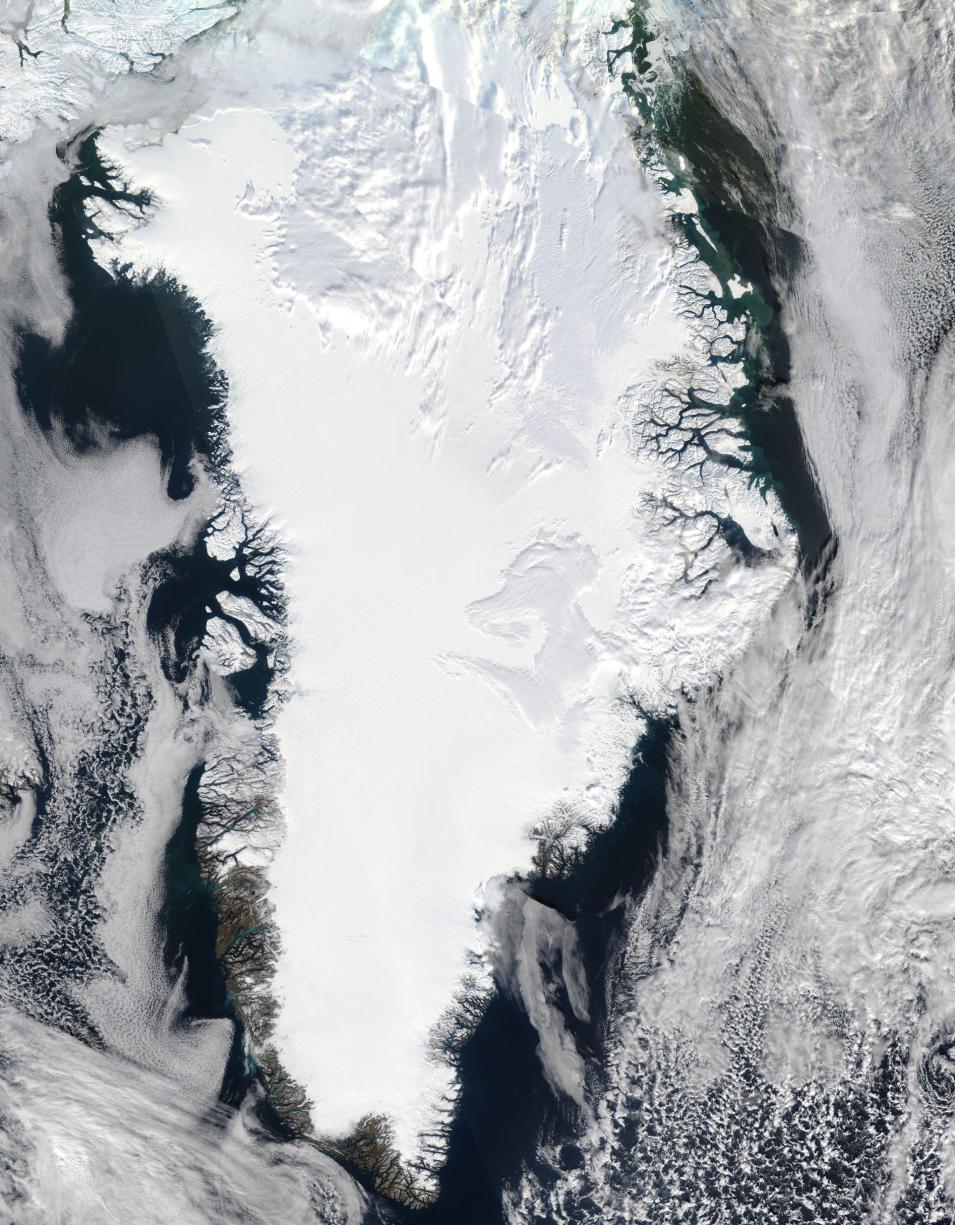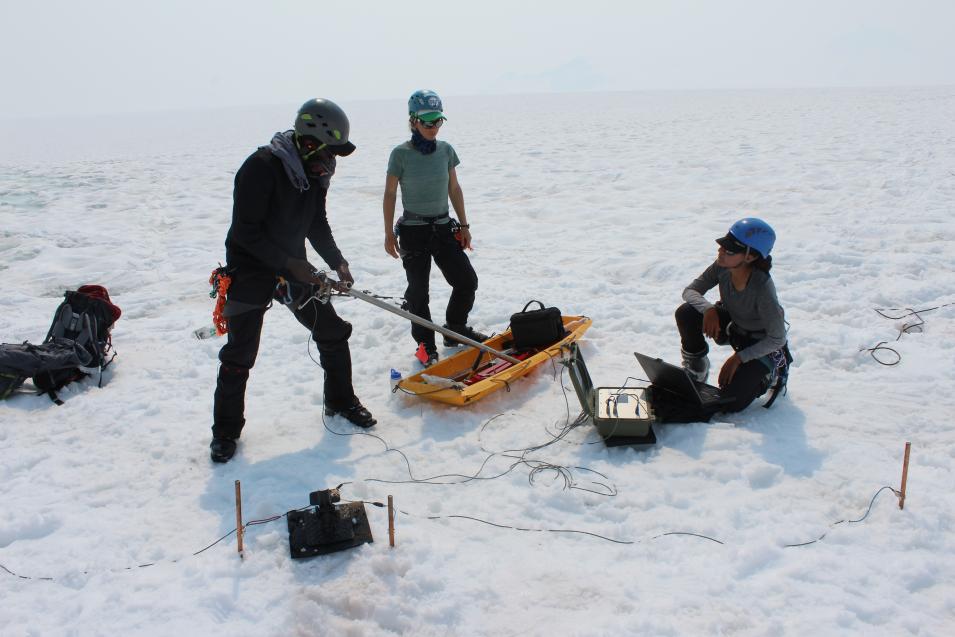According to Poinar, it isn’t clear if the aquifer provides a year-round source of water to the bed or if it is seasonal (summer only) like it is in western Greenland. If the aquifer flows year-round, it likely maintains a more stable network of water channels than is typically found under most glaciers. This would lead to steadier ice flow over the calendar year, limiting the fast lurches that typically happen in spring and summer and, somewhat counterintuitively, reduce the overall amount of ice that flows into the ocean in this part of Greenland.
Data products from Operation IceBridge and ICESat-2 are helping Poinar and her fellow researchers answer some of these questions.
“The Operation IceBridge radar and airborne lidar data allow us to identify water trapped in the aquifer inside the glacier — we can clearly see its upper surface some tens of meters below the top of the ice — and locate the crevasses that drain the aquifer,” said Poinar. “The large influx of water makes these crevasses wider than expected, and we are honing an algorithm to discriminate these special crevasses that connect the aquifer to the bed.”
Poinar and her colleagues detailed this research in a paper published in Frontiers in Earth Science in 2017. Their work revealed that, “most likely, nearly all water in Greenland firn aquifers discharges through crevasses” and that “these crevasses carry the water all the way to the bed, certainly in some locations and most likely in many or most locations.”
These findings are significant, as they help to close the gaps in the water budget of the ice sheet, she said.
Naturally, more work is necessary to develop the next generation of ice sheet and climate models that will improve forecasts of sea-level rise from Greenland’s glaciers and ice sheets. Poinar’s research demonstrates how Earth science data from NSIDC DAAC and other DAACs in NASA’s EOSDIS collection help scientists better understand the interactions among Earth system components.
Representative Data Products Used or Created:
Available through NSIDC DAAC:
- ATLAS/ICESat-2 Level 2A (L2A) Global Geolocated Photon Data, Version 5 doi:10.5067/ATLAS/ATL03.005
- ATLAS/ICESat-2 L3A Land Ice Height, Version 5 doi:10.5067/ATLAS/ATL06.005
- Global Land Ice Velocity Extraction (GoLIVE) from Landsat 8, Version 1 doi:10.7265/N5ZP442B
- Greenland Ice Mapping Project: ice flow velocity variation at sub-monthly to decadal timescales http://nsidc.org/data/measures/gimp
- IceBridge Accumulation Radar L1B Geolocated Radar Echo Strength Profiles, Version 2 doi:10.5067/0ZY1XYHNIQNY
- IceBridge Airborne Topographic Mapper Level 1B Elevation and Return Strength, Version 2 doi:10.5067/19SIM5TXKPGT
- IceBridge BedMachine Greenland, Version 4 doi:10.5067/VLJ5YXKCNGXO
- IceBridge Digital Mapping System Level 1B Geolocated and Orthorectified Images, Version 1 doi:10.5067/OZ6VNOPMPRJ0
- IceBridge Multichannel Coherent Radar Depth Sounder Level 1B Geolocated Radar Echo Strength Profiles, Version 2 doi:10.5067/90S1XZRBAX5N
- IceBridge Snow Radar Level 1B Geolocated Radar Echo Strength Profiles, Version 2 doi:10.5067/FAZTWP500V70
- MEaSUREs BedMachine Antarctica, Version 2 doi:10.5067/E1QL9HFQ7A8M
- MEaSUREs Greenland Ice Sheet Velocity Map from InSAR Data, Version 2 doi:10.5067/OC7B04ZM9G6Q
- MEaSUREs Multi-year Greenland Ice Sheet Velocity Mosaic, Version 1 doi:10.5067/QUA5Q9SVMSJG
Other data products used:
Read about the Research:
Poinar, K. & Andrews, L. (2021). Challenges in predicting Greenland supraglacial lake drainages at the regional scale. The Cryosphere, 15(3): 1455-1483. doi:10.5194/tc-15-1455-2021
Sperhac, J., Poinar, K., Jones-Ivey, R., Briner, J., Csatho, B., Nowicki, S., Simon, E., Larour, E., Quinn, J., & Patra, A. (2020). GHub: Building a glaciology gateway to unify a community. Concurrency and Computation: Practice and Experience, 33(9): e6130-14. doi:10.1002/cpe.6130
Poinar, K., Joughin, I., Lilien, D., Brucker, L., Kehrl, L., & Nowicki, S. (2017). Drainage of Southeast Greenland Firn Aquifer Water through Crevasses to the Bed. Frontiers in Earth Science, 5: 8-15. doi:10.3389/feart.2017.00005
Explore more Data User Profiles



